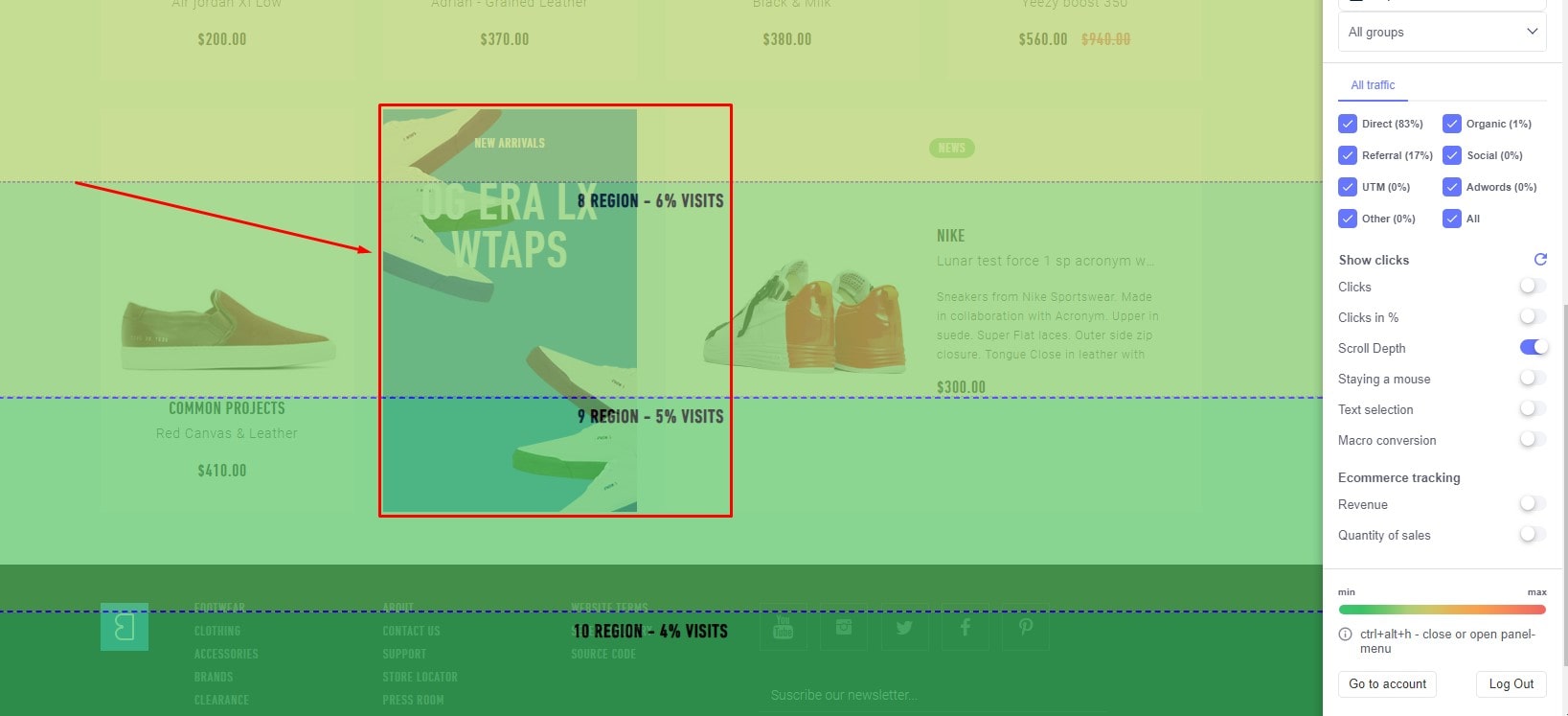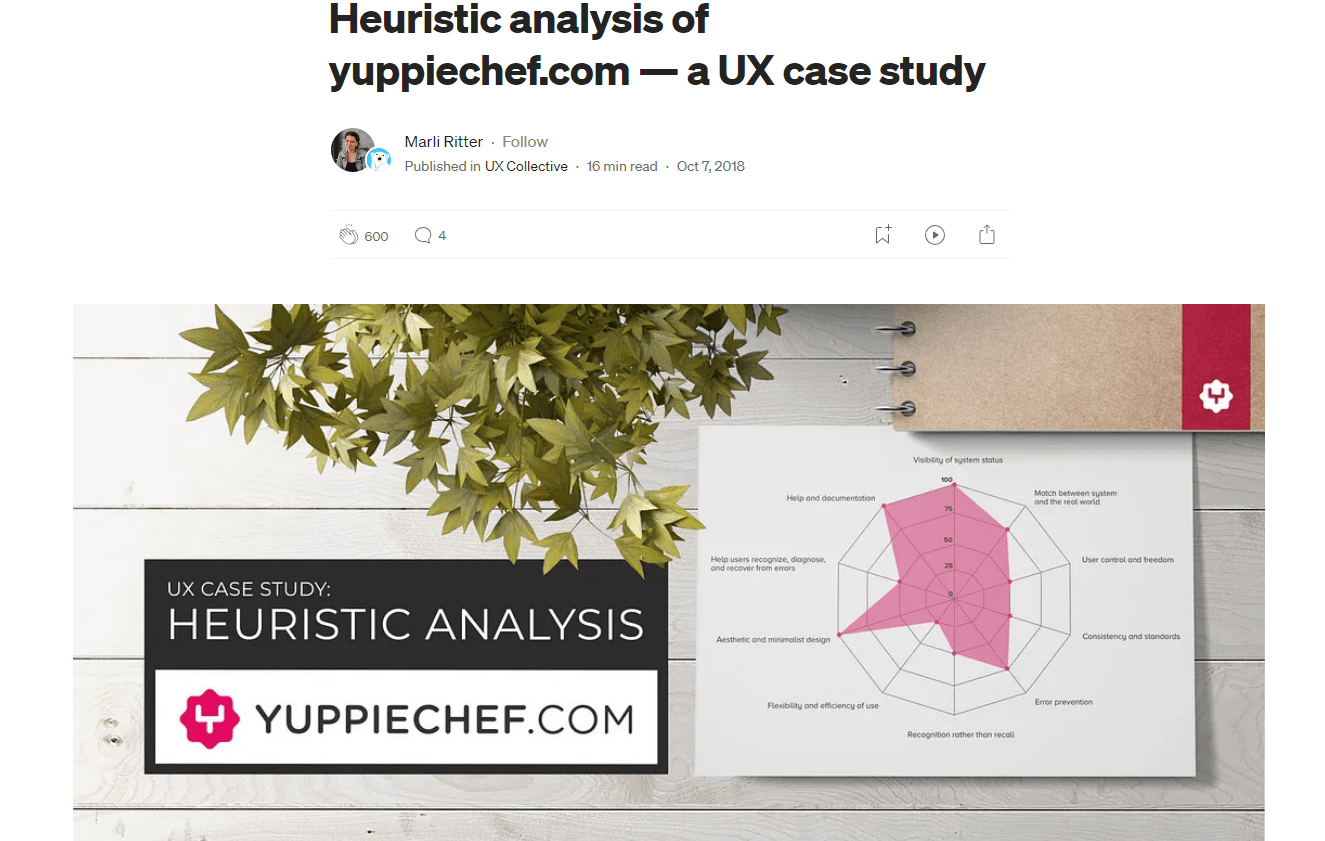In the evolving landscape of digital design, heuristic analysis stands as a cornerstone for ensuring stellar usability. This guide aims to dive deep into the intricacies of heuristic analysis – breaking down its components, illuminating its role in design, and showcasing its potential in elevating user experience.
🔎 Key Highlights:
- Heuristic: The art of problem-solving through experience-based techniques.
- Analysis: Methodical examination to decipher design elements.
- Design: Crafting user-centric interfaces that resonate and engage.
- Usability: Ensuring an interface is intuitive, functional, and user-friendly.
- Evaluation: Continuous assessment to refine and perfect the user journey.

With a blend of these elements, designers can sculpt digital experiences that truly resonate with end-users. 😃 And to supercharge your heuristic journey, consider leveraging Plerdy – the ultimate tool for CRO & UX, streamlining the evaluation process and offering insights that can transform your design strategies. Dive into this guide to grasp the full spectrum of heuristic analysis, and let’s set your projects up for unparalleled success! ⚡
Definition and Background
In the vast landscape of design and user experience, heuristic analysis stands out as a robust tool for enhancing usability. Rooted in tried-and-true principles, this method offers designers and evaluators a systematic approach to identify potential pitfalls before they turn into real issues for end-users. It’s all about applying a set of heuristics – or best practices – to assess the design’s efficacy and user-friendliness.
Consider an e-commerce website. Navigating through product listings should be intuitive, the checkout process streamlined, and any potential roadblocks quickly identified and smoothed out. Here’s where heuristic analysis shines:
- Intuitive Navigation: Ensures users can easily move through pages without getting lost or frustrated.
- Consistency in Design: Makes sure that buttons, links, and other design elements remain uniform throughout the site.
- Clear Calls-to-Action: Guarantees users understand their next steps, like “Add to Cart” or “Proceed to Checkout.”
- Feedback Mechanisms: Provides users with immediate responses, like confirming an item’s addition to a shopping cart.
At its core, heuristic analysis revolves around an in-depth evaluation of a design against established usability principles. By adhering to these guidelines, designers and evaluators can craft experiences that not only delight but also ensure users accomplish their goals with ease. Whether it’s a mobile app aiming to simplify personal finance or an online learning platform striving to make education accessible, leveraging heuristic analysis paves the way for impeccable usability, fostering loyalty and driving success.
The Importance of Heuristic Analysis in User Experience (UX)

In the dynamic landscape of User Experience (UX), heuristic analysis emerges as a cornerstone technique, driving design clarity and enhancing usability. By leveraging heuristic principles, designers dive deep into their creations, pinpointing areas ripe for improvement. This methodical evaluation pares down the chances of oversight and positions a product or service for heightened user engagement.
Take, for instance, a healthcare app designed to track daily medications. Users lean heavily on the app to remind them, log doses, and maintain a consistent regimen. To ensure seamless use, heuristic analysis steps in to:
- Clutter Reduction: Streamline the interface, making sure only vital information stands out.
- Feedback Systems: Establish mechanisms to confirm actions, such as successfully logging a taken dose.
- Error Minimization: Design pathways that guide users away from common mistakes, like double-logging medications.
- Usability Boosts: Enhance ease of navigation, enabling quick access to key features without unnecessary detours.
Implementing heuristic analysis in the design phase paves the way for these usability enhancements, ensuring the app fulfills its core mission with elegance and efficiency. By focusing on the nuances of user interaction, heuristic evaluation brings to light the subtle touchpoints that can make or break an experience. Whether enhancing an online bookstore’s checkout process or refining a digital assistant’s voice recognition, this thorough vetting process is the gold standard. Designers, armed with insights from heuristic analysis, craft products and services that resonate deeply, turning casual users into loyal advocates and propelling the digital experience to unparalleled success.
Principles of Heuristic Analysis
Heuristic analysis stands tall as an invaluable tool in the UX toolkit, enabling designers and evaluators to systematically dissect and refine digital experiences. Rooted in established principles, this method champions usability by holding design under the magnifying lens of best practices, ensuring interfaces resonate with user needs and expectations.
At its heart, heuristic analysis breaks down design into digestible components, scrutinizing each element for optimal usability. For a fitness app aiming to motivate daily workouts, for instance, the principles of heuristic analysis would steer the design toward:
- User Control: Empower users with the flexibility to customize workout plans, adjust settings, or even opt-out of specific exercises.
- Visibility of System Status: Provide real-time updates – whether it’s tracking reps, calories burned, or time elapsed.
- Consistency and Standards: Ensure that icons, buttons, and language align consistently throughout, eliminating guesswork for users.
- Error Prevention and Recovery: Design clear pathways, guiding users away from missteps and offering straightforward solutions if they veer off track.
- Flexibility and Efficiency: Offer shortcuts for seasoned users, enabling them to navigate the app with speed and ease.
- Clear and Concise Language: Cut out jargon, ensuring every instruction or piece of information is easily digestible.
With these principles as a guidepost, heuristic analysis becomes a transformative process. Designers, bolstered by this methodical evaluation, find themselves better equipped to craft digital experiences that don’t just function but flourish. The ebb and flow of a user navigating through a website, or the joy of seamless interaction on a mobile app, all owe their grace to the meticulous attention paid during heuristic analysis. In the vast digital landscape, where competition is fierce and user patience fleeting, heuristic analysis offers that edge, ensuring digital interfaces not only meet but exceed user expectations, setting the stage for success in any niche.
Preparing for a Heuristic Analysis
Gearing up for a heuristic analysis is like prepping for a major athletic event. Just as athletes train, strategize, and gather the right gear, UX professionals must also set the stage to ensure their analysis runs smoothly and delivers insightful results. Dive deep into the blueprint of your digital project, understanding its nooks and crannies, before embarking on a comprehensive evaluation.
Imagine preparing to assess the usability of a groundbreaking food delivery app. A mere glance won’t cut it. To serve up a comprehensive review, one must:
- Gather Essential Tools: Ensure you’ve got wireframes, user flows, and access to the actual platform at hand.
- Know Your Audience: Pinpoint user personas to align the analysis with the intended user’s needs and preferences.
- Define Clear Objectives: Set tangible goals, like increasing user retention or decreasing drop-offs at the checkout.
- Stay Updated on Heuristics: Before diving in, brush up on the latest heuristic principles, ensuring you’re aligned with current best practices.
- Set the Environment: Mimic a typical user setting. If it’s a mobile app, perhaps a quiet cafe or bustling subway might be fitting.
- Plan for Feedback Integration: Chart out how insights will feed into the design iteration process, ensuring findings don’t gather digital dust.
With preparation in place, diving into heuristic analysis becomes a streamlined process. Each click, swipe, and interaction gets evaluated under the vigilant eyes of a UX expert, driven by the goal to optimize usability. From a buzzing social media platform aiming to engage users, to an e-learning portal striving to simplify complex topics, meticulous prep work makes all the difference. By setting a solid foundation, UX professionals are positioned to unravel the intricacies of design, ensuring each digital experience not only delights but also stands up to rigorous usability standards, paving the way for digital brilliance.
The Step-by-Step Process

Embarking on a heuristic analysis is akin to sculpting a masterpiece from a block of marble. Each step meticulously shapes and refines the design, honing it to resonate with the intended user. Whether you’re dissecting the nuances of a boutique e-commerce store or delving into the layers of an intricate gaming platform, a step-by-step approach ensures thorough evaluation and actionable insights.
Here’s how the journey unfolds:
- Kick-Off with Objectives: Before diving headfirst, clearly outline what you aim to achieve. Whether it’s enhancing a registration flow or refining a search function, your goals will guide the process.
- Immerse in the Design: Fully engage with the interface, walking in the shoes of a typical customer. Experience every click, swipe, and hover as they would.
- Apply Heuristic Principles: Use established criteria to weigh the design’s usability. For instance, evaluate how a podcast platform signals new episode releases or how an online magazine highlights trending articles.
- Document Findings: As you navigate, jot down observations. Perhaps the navigation on a travel blog feels intuitive, but the photo gallery lacks a coherent flow.
- Rank Issues: Not all findings hold equal weight. Classify issues based on their impact on usability – from minor hiccups to major roadblocks.
- Brainstorm Solutions: For every hiccup identified, brainstorm potential design tweaks. If users grapple with a cluttered dashboard on a finance app, how can it be streamlined for better clarity?
- Compile a Comprehensive Report: Bundle your insights, recommendations, and solutions into a cohesive report. This document will act as a roadmap for design iterations, steering improvements in the right direction.
- Loop in Stakeholders: Engage designers, developers, and project managers, ensuring everyone’s on board with proposed changes.
The brilliance of heuristic analysis lies in its structured approach. It’s not about random critiques or personal preferences. It’s a methodical deep-dive, aimed at elevating digital experiences. By following this step-by-step playbook, UX professionals stand poised to carve out interfaces that not only captivate but also streamline user journeys, setting the gold standard in usability and design excellence.
Benefits of Heuristic Analysis
In the vast landscape of UX, heuristic analysis stands out as a beacon, guiding designers and developers to craft interfaces that users adore. A scientific approach rooted in principles of design and usability, heuristic analysis delves deep into the fabric of digital products, weaving insights that are pivotal for success.
Consider the myriad benefits:
- Cost-Effective: Unlike extensive user testing, heuristic analysis doesn’t burn a hole in the pocket. By leveraging experts’ know-how, businesses can spot and rectify issues without breaking the bank.
- Swift Feedback Loop: Time is of the essence in today’s fast-paced digital ecosystem. Heuristic analysis offers a quick turnaround, allowing teams to iterate and refine at lightning speed.
- Insightful Depth: Beyond surface-level critiques, heuristic evaluation dives into the nuances. Whether it’s the seamless flow of an online bookstore or the intuitive controls of a fitness tracker, no stone remains unturned.
- Holistic Viewpoint: This approach doesn’t just pinpoint challenges – it provides holistic solutions. For instance, if a healthcare portal’s appointment scheduler feels cumbersome, heuristic analysis won’t just highlight the issue – it’ll suggest ways to streamline the experience.
- Empowered Decision Making: Armed with data-driven insights, stakeholders can make informed choices. Whether it’s green-lighting a feature on a music streaming app or revamping a checkout process, decisions stem from solid foundations.
- Boosted User Retention: As interfaces get honed to perfection, users find reasons to stick around. The delightful experience of browsing an art gallery online or navigating a recipe app ensures users come back for more.
The transformative power of heuristic analysis can’t be understated. It’s like having a magnifying glass that illuminates the intricacies of design, highlighting what shines and what needs a touch of polish. Digital platforms, be it a niche e-commerce boutique or a sprawling social network, stand to gain immensely. By embracing heuristic evaluation, the path to creating interfaces that resonate, engage, and delight becomes clear – setting businesses on course to achieve digital brilliance.
Limitations and Challenges
In the dynamic domain of UX, heuristic analysis has carved a significant niche, establishing itself as a robust tool for enhancing design and usability. Yet, like any tool, it doesn’t come without its set of challenges and limitations.
Navigating through a heuristic evaluation, one can’t help but bump into a few hurdles:
- Subjectivity Issues: While based on established principles, heuristic analysis hinges on the expertise of evaluators. Two experts might draw different conclusions from the same design element. For instance, a navigation bar on a gourmet food website might be deemed intuitive by one analyst and perplexing by another.
- Missed User-specific Issues: Experts carry a wealth of experience, but they aren’t the end-users. An e-learning platform’s feature might pass heuristic scrutiny but still baffle a student trying to access resources.
- Potential for Overemphasis: At times, analysts might fixate on minor hiccups, diverting attention from more pressing issues. A color scheme choice on a travel blog might overshadow the flawed booking mechanism.
- Absence of Quantitative Data: Heuristic evaluation doesn’t dish out hard numbers. While it provides a treasure trove of qualitative insights, businesses craving metrics might feel left in the lurch.
- Scope Limitations: Given its nature, heuristic analysis doesn’t encompass every facet of user experience. It might dissect the usability of a digital art tool but won’t touch upon its server responsiveness.
However, by understanding these limitations, businesses can smartly integrate heuristic evaluation into a broader strategy. Complementing it with methods like user testing or analytics can bridge potential gaps, creating a cohesive approach to refining design and enhancing usability. With a well-rounded toolkit, companies can sidestep challenges, ensuring their digital offerings stand out and cater effectively to their user base.
Integrating Heuristics with Other UX Methods

In the expansive landscape of UX, heuristic analysis emerges as a cornerstone for gauging design and usability. However, it doesn’t operate in isolation. Instead, the true magic unravels when you mesh heuristics with other UX methodologies to form a more holistic evaluation framework.
Dive into the multifaceted world of UX, and you’ll uncover myriad techniques that complement heuristic analysis:
- User Testing: This method bridges the gap heuristic evaluations might leave. While heuristics hinge on expert opinion, user testing taps into real-world user feedback. Imagine an e-commerce site where experts find the checkout process seamless. However, real users, when tested, struggle to locate the final purchase button. Merging these insights can lead to more actionable design improvements.
- Surveys and Feedback: While heuristic analysis sheds light on usability flaws, direct customer feedback can pinpoint user preferences and needs. A digital music platform, for instance, may pass all heuristic criteria but still not meet users’ genre-specific demands. Incorporating feedback can tailor the platform more closely to user desires.
- Analytics and Heatmaps: These tools provide quantitative data on user behavior, supplementing the qualitative nature of heuristic evaluation. If a fitness app’s workout section gets minimal traffic, analytics will flag this discrepancy. Combined with heuristic insights, you can root out design elements that might be pushing users away.
- A/B Testing: After implementing design changes post-heuristic evaluation, A/B testing allows you to measure their efficacy. Suppose a blogging platform revamps its user dashboard based on heuristic suggestions. A/B tests can determine which version—old or revamped—resonates better with users.
Weaving heuristic analysis with these complementary tools crafts a well-rounded UX strategy. While heuristics lay the foundation by pinpointing design and usability hiccups, these auxiliary methods build upon it, refining the UX to its optimal form. It’s this synergy, when honed to perfection, that allows businesses to truly engage and satisfy their digital audience.
Tips for Effective Heuristic Analysis
Navigating the maze of heuristic analysis can feel like a daunting endeavor. But, when done right, it can morph into a powerful tool to elevate design, usability, and overall user experience. To harness the full potential of this method, it’s crucial to understand and implement best practices.
Drawing inspiration from varied niches, here are some actionable steps to amp up the efficacy of your heuristic analysis:
- Stay Neutral: Approach every project with an open mind. By steering clear of biases, you ensure that the evaluation stays objective. Take online banking interfaces, for instance. While some may be dazzled by sleek aesthetics, it’s imperative to zero in on usability and functional efficiency.
- Enlist Multiple Evaluators: Two heads are better than one, and when it comes to heuristic analysis, this couldn’t be truer. Tapping into diverse perspectives can shed light on overlooked design glitches. Imagine assessing an e-learning platform; while one expert might be drawn to the content layout, another might focus on the interactive elements.
- Iterate and Re-evaluate: Don’t settle after a single round of analysis. Instead, use feedback to refine design elements and circle back for another evaluation. Consider mobile apps: If initial feedback suggests a convoluted sign-up process, streamline it and then assess the revised flow.
- Prioritize Feedback: While every observation matters, it’s essential to sift through and prioritize issues that could significantly impact user experience. For a digital magazine portal, ensuring seamless navigation might take precedence over aesthetic tweaks.
- Document Everything: Create comprehensive reports that encapsulate all findings. By maintaining a record, you can easily track improvements and recurring issues. E-commerce sites, for instance, would benefit immensely by monitoring shopping cart design modifications over time.
Incorporating these tips into your heuristic analysis process can not only optimize the evaluation but also pave the way for meaningful design enhancements. By focusing on a thorough, objective, and iterative approach, you position your projects for unmatched customer satisfaction.
Case Studies: Real-World Examples of Heuristic Analysis

Diving into the intricate world of heuristic analysis often yields profound insights, especially when we shine the spotlight on real-world applications. By grounding our understanding in tangible examples, we unravel the tangible impacts of this methodology on design, usability, and holistic evaluation.
- Streamlined Online Shopping Experience:
- Challenge: A leading e-commerce platform faced cart abandonment spikes.
- Heuristic Approach: The evaluation dug into the site’s purchase journey. It wasn’t long before the evaluators flagged a cumbersome check-out process as the culprit.
- Outcome: Post-evaluation, the design underwent a transformation, ironing out kinks, and presenting users with a seamless check-out flow. The upshot? A marked decline in cart abandonment and a spike in sales.
- Revamping a Health App’s Interface:
- Challenge: A health tracking app, despite its robust features, struggled to retain users.
- Heuristic Approach: Evaluators pinpointed that the app’s cluttered design drowned out its core functionalities.
- Outcome: Embracing the feedback, the app’s interface underwent a minimalist redesign, ensuring that users could effortlessly access and benefit from its prime features. User retention rates then skyrocketed.
- Enhancing a Digital Library’s Usability:
- Challenge: A digital book repository witnessed dwindling daily active users, puzzling its creators.
- Heuristic Approach: The analysis dived deep into user navigation patterns. Evaluators quickly identified that users felt lost amidst vast digital aisles of literature.
- Outcome: Intuitive categorization coupled with a revamped search function turned the tide. Users could now easily pick out their desired reads, pushing up daily engagement figures.
- Optimizing a Travel Website’s Booking Process:
- Challenge: A travel portal, known for its lucrative deals, didn’t see the conversions it anticipated.
- Heuristic Approach: Analysts rolled up their sleeves and delved into the booking process, finding that users felt overwhelmed by the barrage of options.
- Outcome: By streamlining choices and presenting them in a digestible manner, users started sailing through the booking process. The site witnessed a surge in completed bookings.
Each of these case studies underscores the transformative power of heuristic analysis. By zeroing in on design hitches and usability roadblocks, and then embarking on a targeted overhaul, businesses can seamlessly align their platforms with user expectations, reaping the rewards of enhanced engagement and satisfaction.
Conclusion
Wrapping up our deep dive into heuristic analysis, it’s clear that this method plays a pivotal role in shaping user experiences in the digital sphere. This technique, rooted in design principles, takes into account usability and aims for continuous evaluation. With heuristic analysis, designers sharpen their understanding of user behavior, paving the way for interfaces that truly resonate with their audience.
As you’ve ventured through this guide, you might have come across various types of evaluation processes and their implications on user experience. Remember these essentials:
- Heuristic: Experience-based solutions to pinpoint design problems.
- Usability: Ensuring the interface aligns with visitor’s expectations.
- Evaluation: Continuous assessment to refine user journeys.
And, for those aiming to push the envelope even further – consider tapping into Plerdy’s SEO & UX analysis tool. This powerful asset can seamlessly integrate into your workflow, offering unique insights to elevate your design strategies. By combining heuristic methods with modern tools like Plerdy, you’re setting your digital projects on a trajectory for unparalleled success. In a fast-paced digital ecosystem, it’s these detailed, methodical approaches that stand out, ensuring longevity and relevance across platforms. Cheers to creating intuitive, engaging, and memorable digital experiences! ⚡
